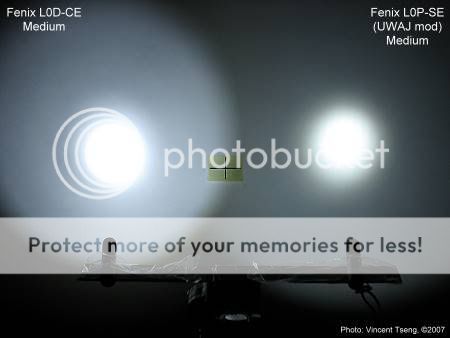The long awaited Fenix Digital L0D CE Cree XR-E based 1x AAA light -
on loan through the kind courtesy of 4sevens (http://Fenix-Store.com)
with accessories -

included: pocket-clip, split (key)ring and spare O-ring.
Size -

the L0D-CE is a fraction longer than my L0P-SE - and looking at the photo more closely one can see the head on the L0D-CE is just a bit longer.
The L0P-SE head will fit on the L0D-CE body - but not the other way round.. the threads seem to want to bind - and I tried more than once - but I did not want to force anything.
Heads -

Part 1 -
compared to a L0P-SE (mod with UWAJ - about as good a LuxIII for this application) using Alkaline AAA
vs. Fenix L0P-SE Special both on default/Medium -


It's pretty obvious that the Cree based L0D-CE is quite a bit brighter.
vs. Fenix L0P-SE Special both on Low


similar difference in brighteness on the Low.
vs. Fenix L0P-SE Special both on High


So - not surprisingly the Cree based L0D-CE shows similar gain in brightness at all three levels over the L0P-SE (with UWAJ mod)
I have heard some ask is the default/Medium level on the L0D-CE as bright as the High on a L0D or L0P-SE?
L0D-CE on Medium vs. Fenix L0P-SE Special on High


simple answer is Yes.....
Cree dark halo - well there is a very slight hint of a dark halo - like there is a less so hint on the L0P-SE (LuxIII) -
- if one looks carefully at the head - the reflector goes up to nearly the LED dome, hardly showing any of the silver surround -
so the dark halo is very slightly there - probably will only bother the most critical.
Current draw readings -
AAA alkaline battery 1.418V open-circuit
Medium = 0.28A
Low = 0.13A
High = 0.75A
Part 2 - using 3.7V Li-Ion rechargeable 10440 - in Post #14
Part 3 - "Practical" Stairway beamshots -in Post #39
Part 4 - L0D-CE on primary alkaline AAA vs. Fenix P1D-CE on primary lithium CR123A - in Post #49
on loan through the kind courtesy of 4sevens (http://Fenix-Store.com)
with accessories -

included: pocket-clip, split (key)ring and spare O-ring.
Size -

the L0D-CE is a fraction longer than my L0P-SE - and looking at the photo more closely one can see the head on the L0D-CE is just a bit longer.
The L0P-SE head will fit on the L0D-CE body - but not the other way round.. the threads seem to want to bind - and I tried more than once - but I did not want to force anything.
Heads -

Part 1 -
compared to a L0P-SE (mod with UWAJ - about as good a LuxIII for this application) using Alkaline AAA
vs. Fenix L0P-SE Special both on default/Medium -


It's pretty obvious that the Cree based L0D-CE is quite a bit brighter.
vs. Fenix L0P-SE Special both on Low


similar difference in brighteness on the Low.
vs. Fenix L0P-SE Special both on High


So - not surprisingly the Cree based L0D-CE shows similar gain in brightness at all three levels over the L0P-SE (with UWAJ mod)
I have heard some ask is the default/Medium level on the L0D-CE as bright as the High on a L0D or L0P-SE?
L0D-CE on Medium vs. Fenix L0P-SE Special on High


simple answer is Yes.....
Cree dark halo - well there is a very slight hint of a dark halo - like there is a less so hint on the L0P-SE (LuxIII) -
- if one looks carefully at the head - the reflector goes up to nearly the LED dome, hardly showing any of the silver surround -
so the dark halo is very slightly there - probably will only bother the most critical.
Current draw readings -
AAA alkaline battery 1.418V open-circuit
Medium = 0.28A
Low = 0.13A
High = 0.75A
Part 2 - using 3.7V Li-Ion rechargeable 10440 - in Post #14
Part 3 - "Practical" Stairway beamshots -in Post #39
Part 4 - L0D-CE on primary alkaline AAA vs. Fenix P1D-CE on primary lithium CR123A - in Post #49
Last edited:










